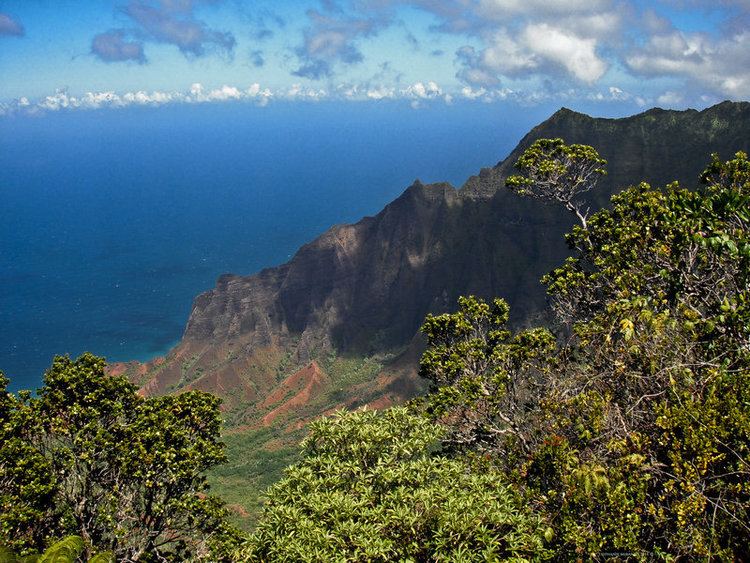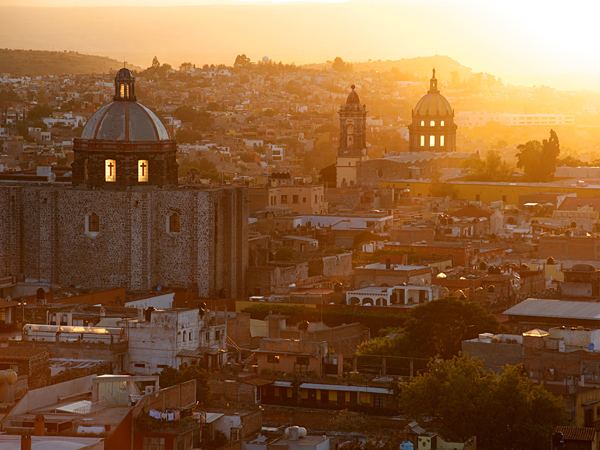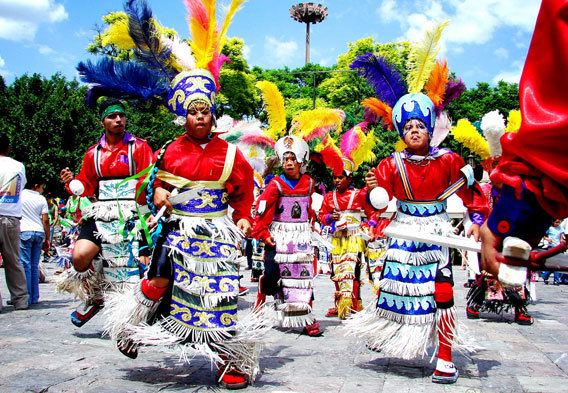Dialing code +52 ISO code MEX Area - Total1,972,550 km2 761,606 sq mi | Capital Mexico City19°26?N 99°08?W? / ?19.433°N 99.133°W? / 19.433; -99.133 Population - 2013 estimate118,395,054 | |
Points of interest Tulum, Chichen Itza, National Museum of Anthropology, Chapultepec, Coba Destinations Similar The Bahamas, Costa Rica, Cuba | ||

Mexico ( Spanish: ), officially the United Mexican States (Spanish: ), is a federal republic in North America. It is bordered on the north by the United States; on the south and west by the Pacific Ocean; on the southeast by Guatemala, Belize, and the Caribbean Sea; and on the east by the Gulf of Mexico. Covering almost two million square kilometres (over 760,000 sq mi), Mexico is the fifth largest country in the Americas by total area and the 13th largest independent nation in the world. With an estimated population of over 113 million, it is the eleventh most populous and the most populous Spanish-speaking country in the world and the second most populous country in Latin America. Mexico is a federation comprising thirty-one states and a Federal District, its capital and largest city.
Contents
- Map of Mexico
- Facts
- Sayulita beach mexico the best place to visit mexico
- History
- Geography
- Economy
- Culture
- Cuisine
- Mexican food street tacos hd
- References
Map of Mexico
In pre-Columbian Mexico many cultures matured into advanced civilizations such as the Olmec, the Toltec, the Teotihuacan, the Zapotec, the Maya and the Aztec before first contact with Europeans. In 1521, the Spanish Empire conquered and colonized the territory from its base in Mexico-Tenochtitlan, which was administered as the Viceroyalty of New Spain. This territory would eventually become Mexico following recognition of the colonys independence in 1821. The post-independence period was characterized by economic instability, the Mexican-American War that led to the territorial cession to the United States, the Pastry War, the Franco-Mexican War, a civil war, two empires and a domestic dictatorship. The latter led to the Mexican Revolution in 1910, which culminated with the promulgation of the 1917 Constitution and the emergence of the countrys current political system. In March 1938, through the Mexican oil expropriation private U.S. and Anglo-Dutch oil companies were nationalized to create the state-owned Pemex oil company.
Facts
Sayulita beach mexico the best place to visit mexico
Mexico has one of the worlds largest economies, it is the tenth largest oil producer in the world, the largest silver producer in the world and is considered both a regional power and middle power. In addition, Mexico was the first Latin American member of the Organisation for Economic Co-operation and Development OECD (since 1994), and considered an upper-middle income country by the World Bank. Mexico is considered a newly industrialized country and an emerging power. It has the fifteenth largest nominal GDP and the tenth largest GDP by purchasing power parity. The economy is strongly linked to those of its North American Free Trade Agreement (NAFTA) partners, especially the United States. Mexico ranks sixth in the world and first in the Americas by number of UNESCO World Heritage Sites with 32, and in 2010 was the tenth most visited country in the world with 22.5 million international arrivals per year. According to Goldman Sachs, by 2050 Mexico is expected to become the worlds fifth largest economy. PricewaterhouseCoopers (PwC) estimated in January 2013 that by 2050 Mexico could be the worlds seventh largest economy. Mexico has membership in prominent institutions such as the UN, the WTO, the G20 and the Uniting for Consensus.
History
Between 1800 and 300 BC, complex cultures began to form. Many matured into advanced pre-Columbian Mesoamerican civilizations such as the: Olmec, Izapa, Teotihuacan, Maya, Zapotec, Mixtec, Huastec, Purepecha, Totonac, Tarascan, "Toltec" and "Aztec", which flourished for nearly 4,000 years before the first contact with Europeans.

These civilizations are credited with many inventions and advancements including architecture, mathematics, writing, metallurgy, astronomy, medicine, and theology.
The earliest human remains in Mexico are chips of stone tools found near campfire remains in the Valley of Mexico and radiocarbon-dated to circa 10,000 years ago. Mexico is the site of the domestication of maize and beans which caused a transition from paleo-Indian hunter-gatherers to sedentary agricultural villages beginning around 5000 BCE.
In the subsequent formative eras, maize cultivation and cultural traits such as a complex mythological and religious complex, a vigesimal numeric system, were diffused from the Mexican cultures to the rest of the Mesoamerican culture area. In this period villages began to become socially stratified and develop into chiefdoms, and large ceremonial centers developed.
Among the earliest complex civilizations in Mexico was the Olmec culture which flourished on the Gulf Coast from around 1500 BCE. Olmec cultural traits diffused through Mexico into other formative-era cultures in Chiapas, Oaxaca and the Valley of Mexico. The formative period saw the spread of distinct religious and symbolic traditions, as well as artistic and architectural complexes.
In the subsequent pre-classical period, the Maya and Zapotec civilizations developed complex centers at Calakmul and Monte Albán respectively. During this period the first true Mesoamerican writing systems were developed in the Epi-Olmec and the Zapotec cultures, and the Mesoamerican writing tradition reached its height in the Classic Maya Hieroglyphic script.
In Central Mexico, the height of the classic period saw the ascendancy of Teotihuacan, which formed a military and commercial empire whose political influence stretched south into the Maya area as well as north. Teotihuacan, with a population of more than 150,000 people, had some of the largest pyramidal structures in the pre-Columbian Americas. After the collapse of Teotihuacán around 600 CE, competition ensued between several important political centers in central Mexico such as Xochicalco and Cholula. At this time, during the Epi-Classic, Nahua peoples began moving south into Mesoamerica from the North, and became politically and culturally dominant in central Mexico, as they displaced speakers of Oto-Manguean languages.
During the early post-classic Central Mexico was dominated by the Toltec culture, Oaxaca by the Mixtec and the lowland Maya area had important centers at Chichén Itzá and Mayapán. Towards the end of the post-Classic period the Mexica.
Alexander von Humboldt originated the modern usage of "Aztec" as a collective term applied to all the people linked by trade, custom, religion, and language to the Mexica state and ?xc?n Tlaht?l?y?n, the Triple Alliance. In 1843, with the publication of the work of William H. Prescott, it was adopted by most of the world, including 19th century Mexican scholars who saw it as a way to distinguish present-day Mexicans from pre-conquest Mexicans. This usage has been the subject of debate in more recent years.
The Aztec empire was an informal or hegemonic empire because it did not exert supreme authority over the conquered lands; it merely expected tributes to be paid. It was also a discontinuous empire because not all dominated territories were connected; for example, the southern peripheral zones of Xoconochco were not in direct contact with the center. The hegemonic nature of the Aztec empire can be seen in the fact that generally local rulers were restored to their positions once their city-state was conquered and the Aztecs did not interfere in local affairs, as long as the tribute payments were made.
The Aztecs of Central Mexico built a tributary empire covering most of central Mexico. The Aztecs were noted for practicing human sacrifice on a large scale, although this generally misunderstood. Along with this practice of delayed death, the killing of enemies on the battlefield was avoided; making their warring casualty rate far lower than their Spanish counterparts whose principal objective was immediate slaughter during battle. This distinct Mesoamerican cultural tradition ended with the Spanish conquest in the 16th century, and over the next centuries Mexican indigenous cultures were gradually subjected to Spanish colonial rule.
Geography

Mexico is located between latitudes 14° and 33°N, and longitudes 86° and 119°W in the southern portion of North America. Almost all of Mexico lies in the North American Plate, with small parts of the Baja California peninsula on the Pacific and Cocos Plates. Geophysically, some geographers include the territory east of the Isthmus of Tehuantepec (around 12% of the total) within Central America. Geopolitically, however, Mexico is entirely considered part of North America, along with Canada and the United States.

Mexicos total area is 1,972,550 km2 (761,606 sq mi), making it the worlds 14th largest country by total area, and includes approximately 6,000 km2 (2,317 sq mi) of islands in the Pacific Ocean (including the remote Guadalupe Island and the Revillagigedo Islands), Gulf of Mexico, Caribbean, and Gulf of California. From its farthest land points, Mexico is a little over 2,000 mi (3,219 km) in length.
On its north, Mexico shares a 3,141 km (1,952 mi) border with the United States. The meandering Río Bravo del Norte (known as the Rio Grande in the United States) defines the border from Ciudad Juárez east to the Gulf of Mexico. A series of natural and artificial markers delineate the United States-Mexican border west from Ciudad Juárez to the Pacific Ocean. On its south, Mexico shares an 871 km (541 mi) border with Guatemala and a 251 km (156 mi) border with Belize.
Mexico is crossed from north to south by two mountain ranges known as Sierra Madre Oriental and Sierra Madre Occidental, which are the extension of the Rocky Mountains from northern North America. From east to west at the center, the country is crossed by the Trans-Mexican Volcanic Belt also known as the Sierra Nevada. A fourth mountain range, the Sierra Madre del Sur, runs from Michoacán to Oaxaca.
As such, the majority of the Mexican central and northern territories are located at high altitudes, and the highest elevations are found at the Trans-Mexican Volcanic Belt: Pico de Orizaba (5,700 m or 18,701 ft), Popocatepetl (5,462 m or 17,920 ft) and Iztaccihuatl (5,286 m or 17,343 ft) and the Nevado de Toluca (4,577 m or 15,016 ft). Three major urban agglomerations are located in the valleys between these four elevations: Toluca, Greater Mexico City and Puebla.
Economy
Mexico has the 15th largest nominal GDP and the 11th largest by purchasing power parity. GDP annual average growth for the period of 1995–2002 was 5.1%. Mexicos Gross Domestic Product (GDP) in purchasing power parity (PPP) was estimated at US $2.2602 trillion in 2015, and $1.3673 trillion in nominal exchange rates. As such, its standard of living, as measured in GDP in PPP per capita was US $18,714.05. The World Bank reported in 2009 that the countrys Gross National Income in market exchange rates was the second highest in Latin America, after Brazil at US $1,830.392 billion, which lead to the highest income per capita in the region at $14,400. As such, Mexico is now firmly established as an upper middle-income country. After the slowdown of 2001 the country has recovered and has grown 4.2, 3.0 and 4.8 percent in 2004, 2005 and 2006, even though it is considered to be well below Mexicos potential growth. Furthermore, after the 2008-2009 recession, the economy grew an average of 3.32 percent per year from 2010 to 2014.
Culture

Mexican culture reflects the complexity of the countrys history through the blending of indigenous cultures and the culture of Spain, imparted during Spains 300-year colonization of Mexico. Exogenous cultural elements have been incorporated into Mexican culture as time has passed.

The Porfirian era (el Porfiriato), in the last quarter of the 19th century and the first decade of the 20th century, was marked by economic progress and peace. After four decades of civil unrest and war, Mexico saw the development of philosophy and the arts, promoted by President Díaz himself. Since that time, as accentuated during the Mexican Revolution, cultural identity has had its foundation in the mestizaje, of which the indigenous (i.e. Amerindian) element is the core. In light of the various ethnicities that formed the Mexican people, José Vasconcelos in his publication La Raza Cósmica (The Cosmic Race) (1925) defined Mexico to be the melting pot of all races (thus extending the definition of the mestizo) not only biologically but culturally as well.
Cuisine
Mexican cuisine is primarily a fusion of indigenous Mesoamerican cooking with European, especially Spanish, elements added after the Spanish conquest of the Aztec Empire in the 16th century. The basic staples remain native foods such as corn, beans and chili peppers, but the Europeans introduced a large number of other foods, the most important of which were meat from domesticated animals (beef, pork, chicken, goat and sheep), dairy products (especially cheese) and various herbs and spices.
While the Spanish initially tried to impose their own diet on the country, this was not possible and eventually the foods and cooking techniques began to be mixed, especially in colonial era convents. African and Asian influences were also introduced into the mixture during this era as a result of African slavery in New Spain and the Manila-Acapulco Galleons. Over the centuries, this resulted in various regional cuisines, based on local conditions such as those in Oaxaca, Veracruz and the Yucatán Peninsula. Mexican cuisine is closely tied to the culture, social structure and popular traditions of the country. The most important example of this connection is the use of mole for special occasions and holidays, particularly in the South and Center regions of the country. For this reason and others, Mexican cuisine was inscribed in 2010 on the Representative List of the Intangible Cultural Heritage of Humanity by UNESCO.
Mexican food street tacos hd
Mexican cuisine is as complex as any of the great cuisines in the world, such as those of China, France, Italy and Japan. It is created mostly with ingredients native to Mexico as well as those brought over by the Spanish conquistadors, with some new influences since then. In addition to staples such as corn and chile peppers, native ingredients include tomatoes, squashes, avocados, cocoa and vanilla, as well as ingredients not generally used in other cuisines such as edible flowers, vegetables such as huauzontle and papaloquelite or small criollo avocados, whose skin is edible. European contributions include pork, chicken, beef, cheese, herbs and spices, and some fruits. Tropical fruits such as guava, prickly pear, sapote, mangoes, bananas, pineapple and cherimoya (custard apple) are popular, especially in the center and south of the country. It has been debated how much Mexican food is still indigenous and how much is European. However, the basis of the diet is still corn and beans with chile pepper as a seasoning as they are complementary foods.
Despite the introduction of wheat and rice to Mexico, the basic starch remains corn in almost all areas of the country. While it is eaten fresh, most corn is dried, treated with lime and ground into a dough. This dough is used both fresh and fermented to make a wide variety of dishes from drinks (atole, pozol, etc.) to tamales, to sopes and much more. However, the most common way to eat corn in Mexico is in the form of a tortilla, which accompanies almost every dish. Tortillas are made of corn in most of the country, but other versions exist, such as wheat in the north or plantain, yuca and wild greens in Oaxaca.
Mexican cuisine is known for its intense and varied flavors, colorful decoration, and variety of spices. Most of todays Mexican food is based on pre-Columbian traditions, including Aztec and Maya, combined with culinary trends introduced by Spanish colonists.
The conquistadores eventually combined their imported diet of rice, beef, pork, chicken, wine, garlic and onions with the native pre-Columbian food, including maize, tomato, vanilla, avocado, guava, papaya, pineapple, chili pepper, beans, squash, sweet potato, peanut, and turkey.
Mexican food varies by region, because of local climate and geography and ethnic differences among the indigenous inhabitants and because these different populations were influenced by the Spaniards in varying degrees. The north of Mexico is known for its beef, goat and ostrich production and meat dishes, in particular the well-known Arrachera cut.
Central Mexicos cuisine is largely made up of influences from the rest of the country, but also has its authentics, such as barbacoa, pozole, menudo, tamales, and carnitas.
Southeastern Mexico, on the other hand, is known for its spicy vegetable and chicken-based dishes. The cuisine of Southeastern Mexico also has quite a bit of Caribbean influence, given its geographical location. Veal is common in the Yucatan. Seafood is commonly prepared in the states that border the Pacific Ocean or the Gulf of Mexico, the latter having a famous reputation for its fish dishes, in particular à la veracruzana.
In modern times, other cuisines of the world have become very popular in Mexico, thus adopting a Mexican fusion. For example, sushi in Mexico is often made with a variety of sauces based on mango or tamarind, and very often served with serrano-chili-blended soy sauce, or complemented with vinegar, habanero and chipotle peppers
The most internationally recognized dishes include chocolate, tacos, quesadillas, enchiladas, burritos, tamales and mole among others. Regional dishes include mole poblano, chiles en nogada and chalupas from Puebla; cabrito and machaca from Monterrey, cochinita pibil from Yucatán, Tlayudas from Oaxaca, as well as barbacoa, chilaquiles, milanesas, and many others.
